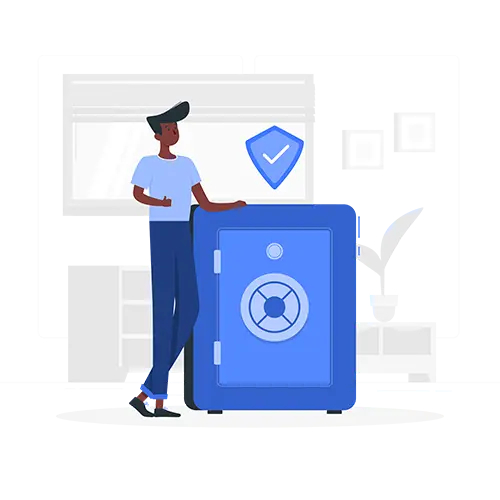“What got us here, won’t get us there,” as the phrase and the title of Marshall Goldsmith’s best-selling book goes. The business world is forced to adapt to global realities and digitalization, even though we got through the major pandemic period.
There have been great breakthroughs in the automation of businesses and entire industries in recent years. In this article, we’ll discuss the frequently asked questions about the digital transformation process.
What is digitalization?
Digitalization, also known as digital transformation, is the process of automating and optimizing business processes with the help of technology. (And yes, this is what HUSPI loves to do.)
There are four major implications of digital transformation on organizations and businesses, as described by Enrique Fernández-Macías:
- New technologies create new job roles and new processes.
- Workplace conditions are changed, requiring meeting more physical, psychological, and environmental criteria.
- Employment conditions also have changed significantly (for example, contractual and social conditions)
- Industrial relations are changed, for example, in how employees and employers organize their relations.
These terms have become quite trendy in the last few years and usually trendy things are just a fad. In the case of digital transformation, it is here to stay because the world itself is becoming more and more digital every day. Countless apps on the app store aim to simplify your daily routines, millions of websites help you streamline your household purchases, and numerous logistics companies use geolocational data to optimize their routes and deliver the goods faster to you.
The number of mobile phone users worldwide is estimated to be between 7.1 billion and 7.49 billion as of May 2024. Here are some sources for these figures:
- Statista: According to Statista, the number of mobile users worldwide stood at 7.1 billion in 2021, with forecasts suggesting this is likely to rise to 7.26 billion by 2022. They project the number to reach 7.49 billion by 2025.
- Exploding Topics: Industry experts estimate that there are approximately 6.84 billion smartphones globally. It’s important to note that this figure refers to smartphones specifically, not all mobile phones.

What digitalization is not – despite the first impression, it’s not so much about the technology itself. The primary focus of digital transformation is on empowering employees and reaching business goals and KPIs with the help of organizational change, processes, data, and technology.
The primary focus of digital transformation is on empowering employees and reaching business goals and KPIs with the help of organizational change, processes, data, and technology.
What is the difference between digitalization and digitization?
Both digitization and digitalization are valid words, but which one of them relates to business processes?
- Digitization is the process of converting something analog, i.e. non-digital, into digital. For example, media such as photos or audiotapes into their digital versions.
- Digitalization deals with business process optimization and automation. Therefore, this is the thing you need when you want to take care of the bottlenecks in the order management system for your retail business, for example.
How to profit from digitalizing your business?
Digitalization transforms the global economy and speeds up globalization. This process has already started and businesses face the necessity to introduce more and more options for remote work to avoid going bankrupt during the lockdowns, promoting digital transformation even further.
One of the main value chains of digital transformation is in empowering employees and clients by communicating with them:
CONNECTED > INFORMED > EMPOWERED.
Empowered employees and clients are much more motivated to use the software solutions because it helps everyone to stay on the same page.
Being digital opens many doors for the business, among them.
- Digitalization for value creation: identifying new business opportunities based on the available data: customers’ preferences, employee performance trends, ideas on improving customer relations using digital tools, etc., especially if your business is traditionally offline (for example, manufacturing industry.) By the way, there is a great book by Andreas Weber on this very topic for business leaders and managers.
- Digitalization for sustainable development: to prepare the business for growth, digital tools are extremely important to scale the operations without losing control.
- Digitalization for business effectiveness and efficiency: tracking the key performance indicators and metrics against the industry benchmarks is important. To make the data simpler to process and extract insights, it’s important to digitalize the business.
What are the challenges of digitalization?
Digital transformation looks different for each given business. There are certain similarities, but still, there’s no one-fits-all template you can apply to your business and win.
Therefore, this vagueness of the term is the initial and primary challenge for everyone involved because it’s unclear at the very beginning what DT will entail.
For example, we had a case for a seafood retail/restaurant. Their initial thought of digitization was to get an e-commerce website for their business, but we ended up creating an entire order management system for them to streamline and automate processes. This was the solution that could take care of the bottlenecks (which would only get worse with “just an e-commerce website” since the number of orders increased.)
Read the case study about the Egersund seafood store and restaurant and how to implement similar delivery and order management product for your business.
How do you overcome this challenge? Business owners should dream alongside development project managers and, united, the technical bottlenecks can be solved.
Another thing that should be taken into consideration is the size of the company because it directly affects the number of employees and interconnected business processes that are involved.
Smaller companies, usually, have fewer employees and departments, which simplifies the transformation. It’s much easier to train 15 people on how to use software than training 10 groups of 15 that should work together and overhaul 5 processes instead of 40.
For larger companies, this process is more challenging because progress should take into account the phasing-in part, where changes are taking place department by department. One also should remember that it’s important to adjust the business processes and expectations during the transition.
What are the common mistakes in digitalization?
Reduced to the most basic steps, digital transformation involves two primary actions:
- Business processes are analyzed to identify bottlenecks (both potential and existing)
- Solutions are proposed, discussed, and implemented.
Is the transformation done? Nope.
The largest step, which we briefly mentioned above, remains: all employees should be trained to use the necessary tools and solutions correctly.
On one hand, it seems quite straightforward, but on the other hand, when solutions are put in place, some employees might be creative with their use without proper training. To have everything working as planned, everyone should understand how to use these new instruments, or else the transformation will be a big money dump.
What else can be done to succeed in digitalization? As we mentioned, smaller companies have an easier journey. For larger companies, however, it is best to have a person whose sole purpose and goal is to manage the transformation process.
What Emerging Roles Are Needed for Digital Transformation?
From company to company, from industry to industry, there are many names for these job positions. Here is a list of roles that help oversee the digitalization process:
Digital Transformation Architects.
This role is a combination of a solutions architect (i.e. knows the development part of the process) and a business-oriented person (i.e. understands the business architecture.) The job of this person is to either transform or create a product that would respond to the needs and expectations of the business goals. These vacancies are also known as Digital Transformation Directors, Digital Transformation Specialists, Chief Digital Officers, Senior Digital Transformation Managers, etc.
While the digital solutions can be developed by an outsourced IT team, it’s better to have a product owner – such as DT Officer – in-house because this person should know how your particular business functions and what pains should be addressed in the first place.
Data Scientists.
Considering the amount of incoming and outgoing data that businesses have to deal with, it’s good if you can have a Data Scientist on board to help you navigate through the oceans of information most efficiently. The insights provided by data scientists and business analysts are helpful for the decision-making process.
Brand Strategists.
Knowing the brand and understanding the company’s values, these people help to create digital strategies that will promote the idea of transformation not only for the employees of the company but also for the clients.
HR Managers.
Human resource managers aren’t a new job title per se, but when it comes to digitalization and employees, there is a hidden danger. Considering that most people have smartphones these days as well as access to a personal computer at home, it’s important to maintain a proper work/life balance and make sure that employees have a chance to keep it healthy.
On one hand, it’s a personal responsibility, but at the same time, it should also be taken care of on the company level to prevent employee burnout and psychological issues that stem from overworking or blurred borders between personal and work life.
Successful Cases of Digital Transformation
Modern technologies are forcing changes in the world. It’s one of those times when you either join Noah’s Ark or sink. While there are some global business trends, each industry has its specific ways of how technology can enhance everyday operations.
Let’s take a look at several examples of digital transformation.
Digitalization in the Banking Sector

What is digitalization in banking? One of the most prominent examples of digital transformation in the banking sector is the creation of so-called neobanks. The financial services industry has been implementing various ways of automation for years and neobanks have taken it to the next level.
A neobank is a FinTech company that doesn’t have any physical branches, offering its entire variety of services online. Often these banks have partners among other “physically present” banking institutions, but it’s not always the case.
For example, one of the Ukrainian neobanks is Monobank, which launched a mobile application, where users can do all operations via the Internet. It streamlines the processes for the client and also reduces the costs for the bank itself for renting the office, for example, or maintaining a lot of employees. Monobank also added a lot of small gamification elements (for example, paying for a taxi ride using the card) that raise users’ loyalty by making it fun to use this particular bank.
Digitalization for banks looks different for each given bank and its strategic overarching goals. Some “more physical” banks go about automating the processes without getting rid of the branches but still offer numerous services in the banking app.
In Ukraine, such an example is PrivatBank, where clients can receive utility bills and pay for them within a couple of clicks (or you can make the payments automatic – as soon as the bill comes), purchase train tickets without having to input a whole lot of personal information, and many other things.
Digitalization in the Education Sector

Many schools have been forced to readjust their educational process in 2020 to match the need to train children in lockdown circumstances. For the majority involved, it hasn’t been simple because:
- Teachers had to readjust their learning materials and learn how to use online tools effectively. They no longer controlled the physical environment around their students, helping them to dive into the learning process. They also could not use their usual visual elements or motivate children to participate in various educational activities.
- Kids also had to do a giant step in readjusting because, besides the lack of socialization, they are used to, they are also in a home environment, where a lot of things distract them from the learning process. Some are fortunate enough to have their own study space, some have access to the Internet and devices to use for studying, and some are more self-organized than others. However, for the majority of students, trying to learn from home has become a challenge.
Especially within the last year, we have seen numerous examples of how digitalization is affecting the education system. Similar to the banks, schools have taken two major strategic routes:
- Adapt the processes to make distance learning more efficient in conditions where online learning is the only option due to restrictions.
- Go completely online and offer a completely different way to study.
Despite different paths, however, there are numerous tools available on the market right now that help digitalize the process for everyone, such as Moodle, Google Classrooms for teaching, Google Forms for tests, Zoom, YouTube, and many others.
One of the tools that helps simplify the communication between the teachers and the parents is an online diary/logbook, where parents can see their child’s grades, missed classes, or special awards. Using this data, the teachers and school administrators can also see the trends within a given class or in school in general, helping to identify weak points that should be accessed with more attention.
Check out our article about one of the online schools called JAMMSchool which is an example of EdTech.
Digitalizing Agricultural Industry

For the uninitiated, it might seem that agriculture is a very offline industry. I mean, you’ve got land, you’ve got crops, you’ve got heavy machinery, you’ve got animal stock… However, we live in a time when even such industries can be, should be, and successfully are already digitalized.
What are some examples of digitalization in farming and agriculture?
- Livestock management (or “Cow Counting”) is an important tool that helps keep track of livestock information, such as their ever-changing number (calf births and other events), breeding-cycle data, animal movements, and individual health records. Such startups as HerdWatch and Farmwizard. have created apps like this already.
- Getting rid of the weeds in a sustainable way that doesn’t hurt the environment as well as good crops is also a vital task. There are lots of herbicides and pesticides used in the industry, but a startup called FarmWise has built a robot with computer vision technology that recognizes the weeds and mechanically removes them.
- Heavy machinery also can be monitored, especially when you hire additional workers to do the job during the high season. A French startup called Karnott created a solution that streamlines the operations by automating the data-gathering process for the distance a machine has traveled, the time it was operated, etc., leaving the operators to focus on doing a job they were hired to do.
- Last but not least in the list of our short examples is the need to automate grass growth monitoring for animals’ grazing. Aberystwyth University has created an app called FarmGRAZE that shows such parameters as grazing system, stock type, sward height, etc. Good food equals good milk and meat, among other things, so it’s helpful to optimize this process as well and know when something requires attention.
We wrote about other ways of managing sustainability in agriculture as well as about a local Ukrainian smart garden startup called GreenWitch.
Digitalization in the Real Estate Industry

Another industry that is literally brick and mortar is real estate. Yes, there are smart homes with all the technologies and everything. However, when it comes to property management, in the last few years, we have seen how digitalization is changing the face of business even when it’s so physically solid and immovable. The buildings remain where they were, but both customers and property managers have a wide variety of tools to optimize their business processes.
Let’s take a look at several representatives of this change:
- There are numerous digital trading platforms, and one of the leaders in digital bidding procedures is Venbona. The HUSPI team worked on this solution to streamline the purchasing process with the help of an auction.
- Tools like HomeHero help property managers run their businesses in such a way that it’s simple and easy to track all data about every property in a single dashboard. There are a million things to keep in mind when you’re managing a property, so optimizing these processes and automating as many of them as possible makes the job a bit easier. A similar tool called Roby.ai uses artificial intelligence for business automation as well as reducing operational costs for landlords.
We have written a separate article on real estate property management startups. Check it out for more businesses that change the landscape of the industry.
Wondering about time-to-value?
Request a no-obligation discovery call and receive a preliminary estimate tailored to your KPIs.


